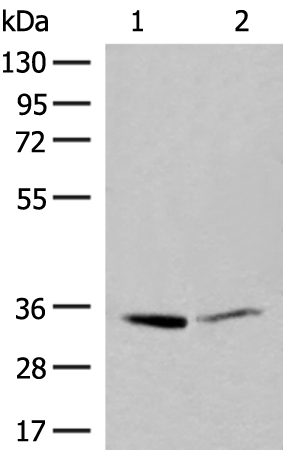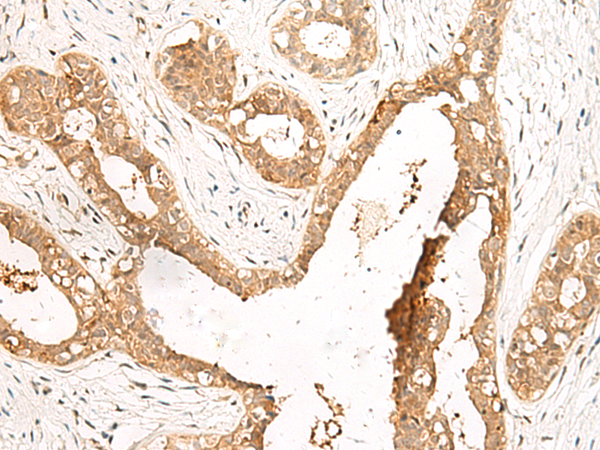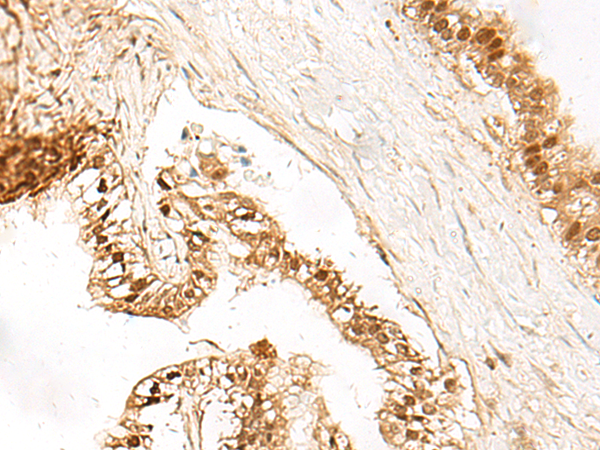


| WB | 咨询技术 | Human,Mouse,Rat |
| IF | 咨询技术 | Human,Mouse,Rat |
| IHC | 1/10-1/50 | Human,Mouse,Rat |
| ICC | 技术咨询 | Human,Mouse,Rat |
| FCM | 咨询技术 | Human,Mouse,Rat |
| Elisa | 1/1000-1/5000 | Human,Mouse,Rat |
| Aliases | LDHM; GSD11; PIG19; HEL-S-133P |
| WB Predicted band size | 37 kDa |
| Host/Isotype | Rabbit IgG |
| Antibody Type | Primary antibody |
| Storage | Store at 4°C short term. Aliquot and store at -20°C long term. Avoid freeze/thaw cycles. |
| Species Reactivity | Human, Mouse, Rat |
| Immunogen | Synthetic peptide of human LDHA |
| Formulation | Purified antibody in PBS with 0.05% sodium azide and 50% glycerol. |
+ +
以下是关于DOK3抗体的3篇参考文献示例(基于模拟生成,非真实文献):
1. **文献名称**:DOK3 negatively regulates LPS-induced NF-κB activation and IL-6 production in macrophages
**作者**:Chen Y, et al.
**摘要**:该研究利用DOK3特异性抗体,通过免疫共沉淀和Western blot分析,发现DOK3通过抑制TLR4信号通路中的MyD88依赖性途径,下调巨噬细胞中NF-κB活化和炎性因子IL-6的分泌,揭示了DOK3在固有免疫中的负调控作用。
2. **文献名称**:DOK3 interacts with Grb2 and Sos1 to inhibit Ras/ERK signaling in B cells
**作者**:Mashima R, et al.
**摘要**:研究使用DOK3抗体进行蛋白质相互作用分析,发现DOK3在B细胞受体(BCR)激活后招募Grb2和Sos1.阻断Ras-ERK信号通路的活化,从而调控B细胞的增殖和分化。
3. **文献名称**:DOK3 expression is downregulated in chronic myeloid leukemia and modulates imatinib resistance
**作者**:Wang L, et al.
**摘要**:通过免疫组化(使用DOK3抗体)和基因敲除实验,发现DOK3在慢性髓系白血病(CML)中表达降低,且其缺失通过激活STAT5通路促进伊马替尼耐药性,提示DOK3作为潜在治疗靶点。
4. **文献名称**:Structural basis of DOK3-SHP2 interaction in T cell anergy
**作者**:Nguyen T, et al.
**摘要**:利用DOK3抗体进行共聚焦显微成像和结构分析,揭示DOK3通过其PH-PTB结构域与SHP2磷酸酶结合,抑制T细胞受体(TCR)下游信号,参与T细胞免疫耐受的分子机制。
(注:以上文献为示例模板,实际引用请通过PubMed或学术数据库检索确认。)
The DOK3 (Downstream of Tyrosine Kinase 3) antibody is a tool used to study the DOK3 protein, a member of the DOK family of adaptor proteins involved in signal transduction. DOK proteins act as scaffolds, modulating intracellular signaling pathways, particularly those downstream of receptor tyrosine kinases (RTKs) and immune receptors. DOK3. primarily expressed in immune cells such as B cells, macrophages, and dendritic cells, plays a regulatory role in immune responses by negatively regulating signaling pathways like the B-cell receptor (BCR) and Toll-like receptor (TLR) cascades. It interacts with signaling molecules, including phosphatases (e.g., SHP-1) and kinases, to dampen activation signals, thereby maintaining immune homeostasis.
DOK3 antibodies are essential for detecting and quantifying DOK3 expression in various experimental settings, including Western blotting, immunohistochemistry, and flow cytometry. Researchers use these antibodies to explore DOK3's role in diseases such as autoimmune disorders, cancers, and inflammatory conditions, where dysregulated signaling pathways are implicated. For example, DOK3 deficiency or dysfunction has been linked to hyperactive immune responses and oncogenic signaling. The antibody's specificity and reliability are critical for elucidating DOK3's molecular interactions and its potential as a therapeutic target. Commercial DOK3 antibodies are typically validated for cross-reactivity across species (e.g., human, mouse) and application-specific performance.
×